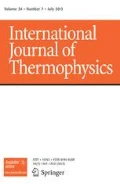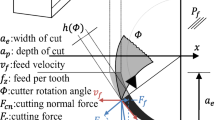Abstract
Theoretical aspects and practical realization of a new method of fast measurement of thermal conductivity of coating materials (like deposits on wall and tubes of the boilers using fossil fuel, or high-temperature ceramics and adhesive materials) are presented. The method is based on analytical solution of the problem of unsteady heat transfer from the heated probe with coating to the environmental air. Several models of the phenomenon, taking into account convection and thermal radiation components of heat transfer, are described. The records of the probe temperature are processed numerically and compared with calculated values based on analytical solution. The best fit between the curves of recorded and calculated temperatures yields thermal conductivity value used as a parameter of the best fitting. This approach was applied to measurement of thermal properties of Fouling deposition in a coal-firing boiler. It was also demonstrated how extended version of the method allows one to represent the thermal conductivity of coating as a piecewise constant function of temperature, using a single record of the probe cooling curve. With a specially designed software for efficient calculation according to developed mathematical model, the whole experiment in the range 1500 °K–300 °K takes no more than 35–40 min, including processing on a regular PC. Validation of the suggested method was carried out in a special experiment with the substance of known thermal conductivity (Corn oil). The method was applied to Fouling depositions of two kinds of fuel—Columbian bituminous coal and Russian bituminous coal. It was demonstrated that Fouling in these two cases is characterized by significantly different thermal conductivity which also changes markedly with temperature.









Similar content being viewed by others
Abbreviations
- λr or λtube :
-
Thermal conductivity of the probe rod (metal tube)
- k1 :
-
Thermal diffusivity of the probe rod
- k2 :
-
Thermal diffusivity of the Fouling
- kav :
-
Average thermal diffusivity of the probe
- λF :
-
Thermal conductivity of Fouling
- CpF :
-
Heat capacity of Fouling
- Cr :
-
Heat capacity of the probe rod
- ρF :
-
Density of the Fouling
- h:
-
Coefficient of heat transfer by free convection from the horizontal tube (the probe) to the air
- ɛ:
-
Emissivity of the Fouling (or the rod)
- Rλ :
-
Spectral reflectivity of the Fouling surface
- TB :
-
Initial temperature of the Fouling just after withdrawal from the furnace
- T∞ :
-
Temperature of the surrounding of the probe (open air)
- Ti :
-
Temperature level defining the radiation component in the boundary conditions
- D:
-
Outer diameter of the Fouling
- L:
-
Length of the Fouling deposits on the probe
- d:
-
Outer diameter of the probe rod
- ri :
-
Radius of the inner surface of the Fouling and outer surface of the probe
- J0, J1,Y0, Y1 :
-
Bessel functions of the first and second kinds
References
O.M. Alifanov, Inverse heat transfer problems, Springer-Verlag, New York (1994)
J.C. Marcelo, R.B.O. Helcio, S.D. George, Inverse and optimization problems in heat transfer, J. Braz. Coc. Mech. Sci Eng, XXVIII(1), (2006)
P. Ludowsky, D. Taler, J. Taber, Solving Inverse heat transfer probems when using CFD modeling, in Numerical Simulation -From Brain Imaging to Turbulent Flows. Ricardo Lopez-Reiz editor, IntechOpen, (2016)
A.G. Blokh, Heat Radiation in Steam Boiler Furnaces (Published in United States, N.p., 1987)
P. Furmanski, Thermal and radiative properties of ash deposits on heat transfer surfaces of boilers. Inst. of Heat Engineering, Warsaw University of Technology, Nr.79, (1995)
W. Richter, R. Payne, M.P. Heap. Influence of thermal properties of wall deposits on performance of P.F.fired boiler combustion chambers. Energy and Environmental Research Corporation. Irvine, CA, 92714, (1982)
N. Menn, B. Chudnovsky, Measurement of thickness and reflectivity of fouling deposits on the wall tubes in a pulverized-coal furnace. Proceedings of ASME Conference Power, Boston, MA, USA (2013)
N. Menn, B. Chudnovsky, New technology for monitoring fouling deposition in coal firing boilers. VGB PowerTech, No. 6, (2016)
H.S. Carslaw, J.C. Jaeger, Conduction of Heat in Solids. Oxford (1959)
Alpastan Tutgut, Ismail Tavman, Sebnem Tavman, Measurement of thermal conductivity of edible oils using transient hot wire method. Int. J. Food Prop. 12, 741–747 (2009)
Acknowledgements
The results presented in this paper could not be obtained without assistance of members of technical team of AMS Co. Eng.Michael Kachko and technician Igal Polovinchik performed measurements on the operated boiler, Eng. Anatoly Minkovsky was involved in design and manufacturing of the probes and testing with Corn oil, Dr. Joseph Krimerman and Eng. Yuri Rubinchik were involved in design and electronic support of reflectivity measurements, and Dr. Alex Bogdanov developed the software codes for all mathematical models and temperature calculation. To all these people the author wants to express his deep gratitude.
Author information
Authors and Affiliations
Corresponding author
Additional information
Publisher's Note
Springer Nature remains neutral with regard to jurisdictional claims in published maps and institutional affiliations.
Appendices
Appendices
1.1 Appendix A
The zone II of the probe is bounded by two cylindrical surfaces, the inner of radius ri and the outer of radius ro. Differential equation of temperature in such a body is
with well-known partial solution
valid for some arbitrary constant values α.
Obeying the boundary condition (8) for any time t, including t = 0, we get
which yields
Substituting in (A1) we receive
Where
From (A3) we get
Using the partial solution of zone I
we get the corresponding component of the heat flux as follows:
We can now use expressions (A3), (A5), (A6), and (A7) in the continuity conditions on the surface r = ri:
Dividing the left side by left side and right side by right side of the above conditions, we get the equation with regard to parameter α \(r_{i} = \mu\):
where \({\text{D}}_{ 1} = \, \mu [J_{1} \left(\upmu \right)*Y_{1} \left( {m\upmu} \right) - J_{1} \left( {{\text{m}}\upmu} \right)*Y_{0} \left(\upmu \right)\left] { + H} \right[J_{0} \left( {{\text{m}}\upmu} \right)*Y_{1} \left( {m\upmu} \right) - J_{1} \left(\upmu \right)*Y_{0} \left( {{\text{m}}\upmu} \right)]\); \({\text{D}}_{ 2} = \,\upmu[J_{0} \left(\upmu \right)*Y_{1} \left( {{\text{m}}\upmu} \right) - J_{1} \left( {{\text{m}}\upmu} \right)*Y_{0} \left(\upmu \right)\left] { + H} \right[J_{0} \left( {{\text{m}}\upmu} \right)*Y_{0} \left(\upmu \right) - J_{0} \left(\upmu \right)*Y_{0} \left( {{\text{m}}\upmu} \right)]\); β = \(\lambda_{F} /\lambda_{tube}\); and m = \(r_{0} /r_{i}\)
All roots of the equation (A8) are the eigenvalues of the differential equations for zone I and II, so all of them should be included in the summation according to expressions (5), (7), and (9) given in Sect. 3.1.
1.2 Appendix B
For the thin rod with heat sources f(x, t) = \(\frac{{2\pi r_{i} }}{{Cp_{tube} * \pi r_{i}^{2} }}H*(T^{I} - T_{\infty }\)) (see [5], chapter IV), we have the following equation related to the temperature \(\vartheta \left( {x,t} \right) = T\left( {x,t} \right) - T_{\infty }\):
which by substitution
\(\vartheta = u*{ \exp }\left( { - \gamma t} \right)\):
is transferred into equation
with initial condition
and boundary conditions
(here we took into account that convection and radiation on both surfaces of the rod can differ from each other).
Again presenting u as a product of two functions u(x,t) = X(x) T(t), we separate the variables using well-known technique of Fourier series which renders the following:
Where
with \({{\mu }}_{2n }\) to be positive roots of equation
Therefore, solution of ϑ from (B1) (and finally expression for T(x,t)) is as follows:
with the elements defined in (B6)–(B7) and (10), (11) in Sect. 3 and we also keep in mind that solutions of equation (B2) corresponding to different roots of (B7) obey the orthogonality conditions.
1.3 Appendix C
Let the full record of the probe covers the temperature range from TB to T∞ and let us divide it into q intervals (segments): the first being from TB to T1 with time duration ∆t1 indexed as q = 1, the second being from T1 to T2 with time duration ∆t2 indexed as q = 2, etc. In each segment equations (C1) and (C2) are remained valid as well as both boundary conditions; however, the initial condition (T(r,0) = TB) is valid only for q = 1, whereas for the second segment the initial condition is
where Bn = \(\{ 2A*J_{0} (\mu_{n}\) /m)/[(\(\mu_{n}^{2} + A^{2} )*J_{0} \left( \mu \right]\) }* and \({{\mu }}_{2n}\) are the roots of (17) (or (B7) or (A8)). Following the general theory we represent solution of equation in segment q = 2 as a Fourier series similar to what was used in the 1st segment, but the eigenvalues and eigenfunctions are different from what was used for segment 1 (because parameters of convection (h2) and radiation (Ti and emissivity) were changed at transition from step 1 to the step 2). For example, we get
where \(\mu_{m}\) are the roots of Eq. (17) (or equivalent, if another model is exploited) with new parameters in boundary conditions and coefficients Bm are defined by expansion of initial conditions (C1) into Fourier series of new eigenfunctions (which all are orthogonal to each other since they are partial solutions of Eqs. (1) and (2)). Following the standard procedure we have
To calculate the first integral in (C3) we divide the r0 on p intervals and find for each coordinate rj = r0*j/p, (j = 0, 1,…p−1) the temperature at the last moment of the first segment, \(T_{1}^{I} \left( {r_{j} ,\Delta t_{1} } \right) - T_{\infty } = \vartheta_{2}^{I} \left( {r_{j} , 0} \right)\) as per (C1). Then, using standard way of integral calculation we get
where \(\delta r = r_{0} /p\). And for the second integral in (C3) we have
with A = \(r_{0} *h_{2}^{' } .\)
Substitution of (C4) and (C5) in (C3) and then Bm in (C2) allows one to find temperature in segment 2 at each location r and time t.
Proceeding further in a similar way one can find the temperature distribution in segment q = 3, and then for q = 4, etc. It should be kept in mind that time-dependent component of segment q (the exponents of (C2) and corresponding expression for the other segments) comprising the sum (\(\Delta t_{1} + \Delta t_{2} + \ldots + \Delta t_{q - 1} )t\) is related to all previous segments.
Rights and permissions
About this article
Cite this article
Menn, N. Novel Method of Fast Measurement of Thermal Conductivity in Wide Range of Temperatures. Int J Thermophys 42, 53 (2021). https://doi.org/10.1007/s10765-020-02758-w
Received:
Accepted:
Published:
DOI: https://doi.org/10.1007/s10765-020-02758-w



